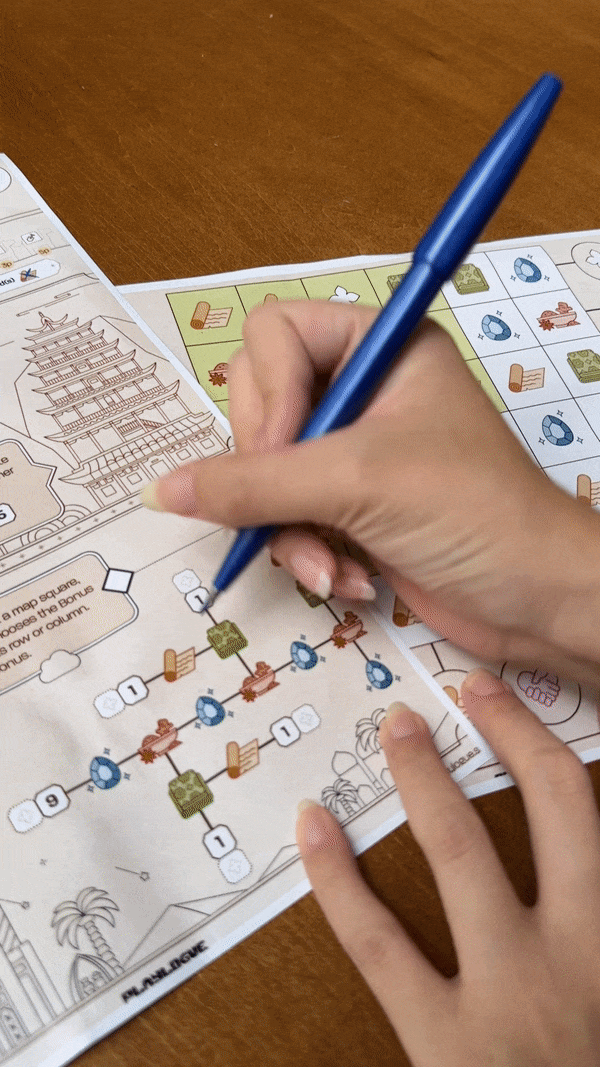Merchant Trails Design Diary #2: Silk Roads Theme & Mechanics
This is a series of design diaries about our Print & Play game Merchant Trails. Read part 1 about how we set the game’s direction and central mechanics here.
A Spring in Our Step
We knew we were on to something once the theme itself started to generate ideas for the game’s mechanics.
For instance, after initial playtesting, we realised that players found it hard to plan around opponents because there was simply too much going on to know what resources everyone else was looking for. Players would try, but then quickly become overwhelmed by the complexity of each player sheet.
The “being a trader” story suggested a simple fix: at the start of each round, all players made a trade agreement that had to be publicly declared. Successfully fulfilling this agreement would net the player bonus points. Narratively, this was the equivalent of a merchant taking on a contract: they committed to (either in this or a subsequent turn) getting a specific good to a specific place, and would gain a tangible reward for doing so.
Players make trade agreements by circling a good on their player sheet and declaring it to the table. They get to cross it out if they retrieve that good from the map, earning them 1VP.
This immediately hit a few important points for us: (i) it made planning around – and hence interacting with – other players easier; (ii) it regularly interrupted the silence that can creep into the later turns of a math-y optimisation game; and (iii) it naturally encouraged a call-and-response dynamic at the table. Since so many of your options are tied to the player upstream of you, players would often weave in requests, threats, and – especially when they’ve been stuck on the same trade agreement for a few turns – complaints into their start-of-round update.
Where Our Paths Cross
Crucially, this system enriched, rather than detracted from the activity happening on each player’s own sheet. Because you could reasonably hope for – but weren’t guaranteed – your Trade Agreement, each round starts with a simple-but-engaging question: what do I pick?
Beyond that, the presence of Trade Agreements as a game term meant they could be added in interesting ways to other game systems too. For example, an option the starting player has simply gives them one copy of whatever they’ve currently circled as their Trade Agreement – serving both as a “safety valve” so that no one resource is truly ever exhausted on the map, and also to texture the map as the game progresses. Because the value of this option is so easily apparent, its row and/or column tends to get used up faster than the others. This can lead to moments where other players either cheer on the leader for stifling their downstream friend, or offer makeshift deals (“if you don’t shaft me this round, I’ll make sure to help you when I’m the leader!”).
The rowdy negotiations that come from other players determining your route on the map.
In fact, in more experienced groups, as the game progresses, the game slowly shifts from resource management to a blend of a routing puzzle. Experienced caravan leaders study the map, taking into account who’s made what trade agreements (and hence which squares they can be expected to land on), what resources have already been used up, and what potential bonus they can snag for themselves after the last player’s selection. All the while the other players cajole, plan, and chatter.
This intersection is what the game strives to achieve: the crossing of casual diplomacy, and (slightly!) crunchier planning. It won’t be for everyone, but we’ve found that a surprising number of players come for one, then end up staying for the other.
New Discoveries
One last part of the game that might be less apparent to players is the research that we did to try to do justice to the theme. The Silk Roads are a popular setting across media and pop culture, and while its sense of adventure is undeniable, we also wanted to ground the game in a little bit of the route’s historical richness.
For instance, we chose to set only one of the game’s three maps in the stereotypical desert. The other two reflect the northern steppes route and southern maritime route, two trade routes that we often don’t associate with the “Silk Road(s)”. We hope that in playing with the maps, people start to realise their existence alongside the traditional desert pathway.
Our Across the Steppes map, which features the rolling green northern steppes, a less well-known terrain on the Silk Roads.
Similarly the name of the game – the Silk Roads – is meant to reflect this updated understanding. We knew some players might be more familiar with its singular appellation, but we wanted to emphasise its networked nature, which is a popular framework in modern scholarship.
These considerations even feature in the game’s mechanics themselves. They range from the subtle (Dunhuang’s special ability indirectly references the system of wealthy patronage that led to the flourishing of its Mogao caves), to the overt (the desert map’s oasis system). Wherever possible, we tried to tie the game to the Silk Roads’ incredible history.
We’ve just released 2 new cities for Merchant Trails: The Silk Roads! Get the full game for free by subscribing to our newsletter.




